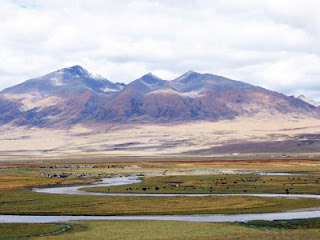The Consolations of Sugarloaf
A week away from the winter solstice, I set out on a 5-hour run, up and down the white-, yellow-, blue-, and purple-blazed trails of Sugarloaf Mountain. Sugarloaf is a monadnock, a compact oasis of rock and tree surrounded by farmland. Scarcely a mountain at 1282 feet, some of Sugarloaf's quartzite-littered climbs are as steep and rocky as you'll find anywhere--high enough to create a distinct microclimate with its own peculiar mix of flora and fauna (chestnut oaks among the former, rattlesnakes and copperheads among the latter).
From where I live in Maryland, the mountains of Virginia and West Virginia are just a little too far to drive for an ordinary weekend long run. So, at just 50 minutes from DC, and less than that from my home in Silver Spring, Sugarloaf has become my default mountain, the place where, for better or worse, I prepared for the rocks and the verticals of Grindstone.

 I love watching the mountain change through the seasons. My last time up here had been on a light-dappled warm morning in September (left photo). On this December day, however, the pale sun faintly reveals itself through the gray clouds. Even by noon the dim light barely illuminates colorless, leaf-strewn trails. I am mostly alone. Familiar trails look strange. Indeed, some of them have been reconfigured, rerouted by twisted, fallen trees left over from "Superstorm Sandy" (right photo shows part of the purple trail).
I love watching the mountain change through the seasons. My last time up here had been on a light-dappled warm morning in September (left photo). On this December day, however, the pale sun faintly reveals itself through the gray clouds. Even by noon the dim light barely illuminates colorless, leaf-strewn trails. I am mostly alone. Familiar trails look strange. Indeed, some of them have been reconfigured, rerouted by twisted, fallen trees left over from "Superstorm Sandy" (right photo shows part of the purple trail).
For its modest size, Sugarloaf has had its brushes with both fame and fortune. FDR had a mind to buy the area up for a nearby Presidential retreat. Thankfully, Gordon Strong, the patent lawyer from Chicago who over a period of years and multiple purchases came to own most of the mountain, cannily managed to steer the President northward, to what is now Camp David. I am thankful, too, that Strong put the kabosh on Frank Lloyd Wright's grotesque plan for an automobile-centric spiral at the top of the mountain (the plan became the prototype for the Guggenheim Museum in New York).

 I love watching the mountain change through the seasons. My last time up here had been on a light-dappled warm morning in September (left photo). On this December day, however, the pale sun faintly reveals itself through the gray clouds. Even by noon the dim light barely illuminates colorless, leaf-strewn trails. I am mostly alone. Familiar trails look strange. Indeed, some of them have been reconfigured, rerouted by twisted, fallen trees left over from "Superstorm Sandy" (right photo shows part of the purple trail).
I love watching the mountain change through the seasons. My last time up here had been on a light-dappled warm morning in September (left photo). On this December day, however, the pale sun faintly reveals itself through the gray clouds. Even by noon the dim light barely illuminates colorless, leaf-strewn trails. I am mostly alone. Familiar trails look strange. Indeed, some of them have been reconfigured, rerouted by twisted, fallen trees left over from "Superstorm Sandy" (right photo shows part of the purple trail).For its modest size, Sugarloaf has had its brushes with both fame and fortune. FDR had a mind to buy the area up for a nearby Presidential retreat. Thankfully, Gordon Strong, the patent lawyer from Chicago who over a period of years and multiple purchases came to own most of the mountain, cannily managed to steer the President northward, to what is now Camp David. I am thankful, too, that Strong put the kabosh on Frank Lloyd Wright's grotesque plan for an automobile-centric spiral at the top of the mountain (the plan became the prototype for the Guggenheim Museum in New York).
I'm thinking about Strong today. The news from Connecticut has been weighing heavily--an unspeakably sad event, the shooting of more than 20 young children, their teachers, their principal. On some of the hills, I choke up, struggle to redirect my thoughts. Sadness and aerobic exercise really do not mix. So I think about Strong, whose vision it was for this mountain to serve as a refuge for schoolchildren from his native Chicago. Who believed a connection to nature is essential, and that an appreciation of natural beauty will make us better people, redeem us. Is it enough, this slender hope? Gordon and Louise Strong thought so, and the period in which their vision for the park came together, the 1930s and 1940s, were as bloody, dark, and violent as any in history.
Increasing effort puts an end to my thinking, hopeful or despairing. I haven't run on hills of any sort since early October, and by the end of the five hours my quads are burning. With a quickening step and quieter mind, I descend the rocky white trail one last time to the parking lot below.
Links
Sugarloaf Mountain, Stronghold, Inc
Hiking Upward, maps and trail information
Increasing effort puts an end to my thinking, hopeful or despairing. I haven't run on hills of any sort since early October, and by the end of the five hours my quads are burning. With a quickening step and quieter mind, I descend the rocky white trail one last time to the parking lot below.
Links
Sugarloaf Mountain, Stronghold, Inc
Hiking Upward, maps and trail information



Comments
Post a Comment